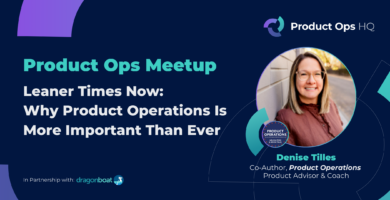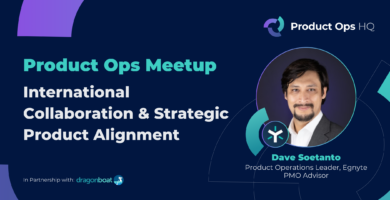Events • On Demand | Watch Time: 45 min
Responsive Product Portfolio Management: 6 Pillars for Success
In this webinar on Responsive Product Portfolio Management, Dragonboat CEO & Founder, Becky Flint, discusses the need for broader portfolio level collaboration and a single source of truth in the post-covid world. Becky covers:
- What is Responsive PPM and why is it critical for success in 2021
- How (and why) to tie planning, execution and insights together for company strategy
- Adjusting priorities based on portfolio outcome and the state of the market and business
Transcript
This transcription has been paraphrased for readability
Bhaji Illuminati: Thank you so much for joining today’s webinar on the six pillars of responsive product portfolio management. Our speaker today is Becky Flint, CEO, and founder of Dragonboat. She has an incredible background, building the product portfolio functions for PayPal, Bigcommerce, and Shutterfly to name a few, and has led over 10 million hours of product roadmap through her career. Becky Flint founded Dragonboat in 2018 because she was tired of working out of spreadsheets. She wanted to build a product that created a central platform with an end-to-end use-case that helped connect customer-needs, business-goals, and product-strategies before and after Scrum, to help companies achieve the maximum portfolio yield.
Becky Flint: Before I get started, I want to put a little bit of framework on the terms we use every day. On the product side, we start with ideas, we prioritize them, and then product and program management comes together as we plan how to build it. Then we’ll go through the execution with the teams that are chosen, scrums, account-bonds, and so on. And part of the workflow is also to provide reporting. What is the next piece? The next piece is combining them and adding one more critical element, allocation. Allocation of different products, programs, and the roadmaps together. This is product portfolio management. And over the years, it has become increasingly practiced.
Introduction to Responsive Product Portfolio Management
The new digital, agile-age, and fast-changing world has introduced a new need for responsive PPM. It’s all the elements that we saw earlier in a continuous and evolving phase. And there’s a connector that connects the product program management with the rest of the business. It could be called objectives and business outcomes. Mixed with the business goals, this is called a responsive PPM, and this is how we tie different pieces of the product, the customer, and so forth into a framework. In this way, responsive PPM is product management plus program management. You tie them together. So then the art and science of responsive PPM is picking the right mix of product investment, so that it will best achieve a total outcome for your portfolio, just like a financial portfolio.
So why do we have to look at this? Portfolio management has always existed, it’s something layered on top of the team’s work. Execution is a part of the overall picture. In the past, it was waterfall activities, you have a centralized top-down control type of portfolio management. Today the world has changed. The teams are moving fast. The world is moving fast. We need interaction between top and down, between the planning, ideation, and execution. Multidimensional, multi interactional communication between teams, strategy, and customers really lead us to the framework that helps us help companies. Leading companies like Paypal, Amazon, and Spotify use this framework to time the moving pieces together and forward.
A Push for Change
So, now, this is how we operate. It’s no longer a one-way demand-direction from executives to teams. And the interaction that happens here really ties a different time horizon, you can see executives looking at a longer time horizon, focusing on a quarter. And then the managers or directors and a lot of the audience is looking at the quarters. How is the focus on this first month and so on, tied to your team’s execution, and how is this framework tied with a platform, tied with objectives and tasks with intermediary activity. Those are initiatives, the projects, and our features, that your organization can move with a faster adjustment. And that is a responsive way of building products holistically as a portfolio.
Now, this is something new. A standard law is something different, it’s actually a way of tying the existing framework together. It works with agile execution, it could be Scrum or could be combined. It could even be a traditional waterfall because different types of team execution is warranted in different cultures. Now it is also tied to a scaled agile framework because at the higher level, your portfolio has its cadence, a rhythm that we tie your quarterly or rolling RPI planning into your bi-weekly, that ties into Scrum. Then you can do the check-ins based on the outcome of your portfolio, you can set and modify your next areas of focus. So in a little bit, we’ll show you how the connector becomes the beginning and the end of the cycle of responsive PPM that’s closing that loop.
Responsive Product Portfolio Management Pillar 1: Allocation
The first element of the portfolio is allocation. Similar to a financial portfolio, if you’re running a financial portfolio, you have probably heard that the proper allocation of the portfolio is the single most important thing as the overall outcome of the portfolio. It’s more important than the individual investment you choose. It’s similar to a product portfolio, in how you allocate your product investment, i.e. what features to work on, what project to work on, where you put your resources across your portfolio is super important. Now it is also a multi-dimensional portfolio. Meaning how you look at things is more than just one way of prioritization. One, it could be the customer dimension, it could be your strategic dimension, it could be your horizon-dimension.
That is how we build and think about portfolio management in the context of a modern, agile responsive organization. The best practice is learning how to run a product portfolio across different sides of the company’s different levels of maturity. That will truly allow the company to become agile at the scale.
Responsive Product Portfolio Management Pillar 2: Inputs
The second part of responsive PPM is the inputs. Now we know where we want to allocate our product investment and resource investments. We need to evaluate what’s coming in, we must take a broader view from different parts of the organization. These inputs are not marching orders, these inputs need to become the inspiration so that you can use them to correlate and come up with product ideas. They’re not one to one, you could have one request breaking down to multiple product features, and each of those product features could be supporting multiple requests.
Responsive Product Portfolio Management Pillar 3: Prioritization
Now we can talk about the allocation by various dimensions. And we talk a little bit about how we look at a request coming in that will help us have more insights to create our portfolio and funnel. The next one obviously is prioritization. We never run out of things to do. The unique part of taking a portfolio approach is that we will take an allocation first approach. In the example we saw, we are looking at the objectives, we may also allocate it by the type of product we build. Allocation becomes your guidepost; you can compare apples to apples within the same bucket of your portfolio. From that, you can then use quantitative or qualitative ways to prioritize.
Traditionally companies use ROI as a common practice model used by product teams. In Dragonboat, we have an additional proprietary measure which is called a metric over available resources or MoaR. Here you see your progress towards the goals and resources needed to support those initiatives and ideas into a more directly comparable effort. Then you can do a prioritization at a higher level based on the allocation. We will know when we are on track and when we are off in terms of our estimation. We can then make adjustments along the way.
Responsive Product Portfolio Management Pillar 4: Planning
Now that we talked about prioritization and allocation, the next step of responsive PPM is planning. I think about our workflow from ideation prioritization into the planning phase. The planning phase is somewhat equivalent to a handoff or collaboration. Now, obviously, program management could also tie to engineering if you’re in a tech environment. So the roadmap has moved on to the release planning. Start looking at what your timeframe could look like. You could look at things as precise or chunked as a quarterly roadmap or a quarterly product increment. You can also look at a fuzzy timeline by month or by quarter to give you a flexible look at your product and release without having to plan everything out.
As a part of the release planning and product increment planning, you also start to add the elements of execution. What are the estimates? What are the resourcing needs, if we need to think about resourcing? How are you thinking about dependencies? As most teams face today, that product is not built by one team. One engineer does not build it. So when you account for these kinds of dependencies with multiple needs and join them both, the responsive portfolio helps you look at them from the lens of prioritization. This is something where you really tie pieces together.
So you can see how when you start to have a responsive portfolio, you can tie these pieces together to create a release roadmap, a product roadmap, that’s not only just the direction we want it to go. It’s something that will drive results and tie what we have, which is our team’s resources. That’s our investment. We want to deliver the outcome we need. That’s the pillar for the allocation planning.
Responsive Product Portfolio Management Pillar 5: Execution
The next pillar of responsive PPM is execution. The focus of Dragonboat is execution, to really connect the product and the portfolio piece into the team tools. People could use JIRA, they can use Asana, they can use any tools to their preference, we don’t dictate what they do. We also don’t dictate how the team is going to practice their execution. It could be Kanban, could be Agile, it could be traditional.
The idea is that we provide the guide to the team so that they know what to focus on. Then we will have visibility of what was happening from the team tool in Dragonboat through a very seamless, robust integration. Additionally, we can predict the progress the team made. Then we can tell if we are going to make the previously targeted time or not. The goal is to be able to spot challenges or issues early so that we can mitigate it.
You might ask “Do we have a timeline? Is it hard to make that timeline? Not necessarily. The reason is that when you put a portfolio together, everything is based on assumption, the product outcome is assumed, we think if we build this, we’ll get this outcome, the resources we need to build a product. Every step of the way, we need to validate our assumption, is it still true or not. And this prediction, it’s a rolling prediction of where we are. As soon as we start to see our previous assumption of how much resource and time this product feature needs, we can make a portfolio-level adjustment decision because you’re not just changing that product feature. The goal is to have an informed decision on should we continue, should we change, should we change others. That’s the managed execution element of it.
Responsive Product Portfolio Management Pillar 6: Reporting
Managing executions are important because that’s what would really have a ripple effect. Anything fails. So as a part of the product portfolio, this is the last critical element.
The last of the pillars of responsive PPM, is stakeholder reporting. All of us operate teams with various cross-functional teams that have different stakeholders. Remember in the early phase of the product portfolio, we have the stakeholder request. First, they will be informed and provide inputs to the portfolio itself. Now, we add another element of the portfolio, which is how to keep them informed so that changes can come into the portfolio as inputs, ideas, and requests.
Stakeholder reports are a key element of the stakeholder management. The other part of the report is not necessarily for immediate cross-functional stakeholders, but for the portfolio owner, product manager, director, and VP of the product, who all want to know, “How are we doing? Do we have a plan?” Well, do we prioritize our outcome to match our understanding, and look at what kind of changes we’ve made throughout the last two, three months, or two quarters? These are the insights for us, just like if you receive your investment statement, it will show you how you’re performing so that you can learn and adjust as well. Dragonboat will help you automate that process.
The Connector: OKRs
So now, once we have gone through the six elements of a responsive PPM, from the allocation to ideas, prioritization, planning, execution, and reporting, what is next? The next one is the connector. That’s the responsive part of responsive PPM, which will close the loop. We have to figure out did it really move the needle? Did we meet the target we set? This shows that the progress of the goals needs to be tracked to close the loop. That’s why we built Dragonboat.
In Summary
These are the six pillars of responsive product portfolio management, with the OKR as the connector. The six pillars will start and end with the OKR element so that not only are you looking at the pieces of the workflow, but also the benefit of that.
Responsive product portfolio management helps you deliver customer delight, there’s customer elements of every product organization or every organization. It will help you accelerate business results, because these two different dimensions and the responsive portfolio, tie these pieces together. And then there’s the stakeholder management elements of that as well. Now, stakeholder management is one of the most challenging of almost all the product and program leaders. And the reason is because you have so many inputs, so many different ideas, so many different priorities, how do you tie them together? First, achieve a goal alignment, then achieve agreed on allocation. From there, all the conversation will be so much easier. And with the goal alignment with the right allocation and clear participation based on the business results and customer delight, you can empower your team, regardless of their engineers, designers, sales teams, and support team.
Final Thoughts
Everyone wants to do the best of their job, they want to make sure they can deliver customer delight, and accelerate business results. That’s how you group them together by keeping everything in one place to know why we are working on what we are working on. Why it matters, what results we have achieved. Dragonboat is the tool that makes it easier to keep track of everything. It increases your impact to so much more than if you would bury yourself in spreadsheets, PowerPoints, and meetings. When people see that you are making the best decision for the company, with the given and goal, you demonstrate yourself to be a valuable contributor to the company, and it helps you grow your career.
I will just summarize this in a quick quote that one of our customers, a now good friend of ours, said, “when you give good people a great tool, amazing things will happen”. And I think she totally got what this is about. We’re here to provide a tool and a platform to product managers, program managers, technology leaders, transformation leaders, all of you who are actually happy to do hands-on work and manage all these moving pieces. We will provide the tools and systems to help you to be successful.

Featured Speaker

Becky Flint
Founder and CEO of Dragonboat
Becky is a product and tech executive based in the Silicon Valley. She has built and scaled product and engineering teams globally for both startups and Fortune 500 companies. Currently Becky is the Founder and CEO of Dragonboat with a mission to empower responsive leaders and their teams to build better products faster. Prior to founding Dragonboat, Becky has held executive roles at Feedzai, Bigcommerce, Tinyprints/Shutterfly, and PayPal.


